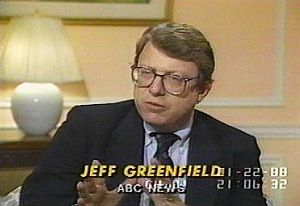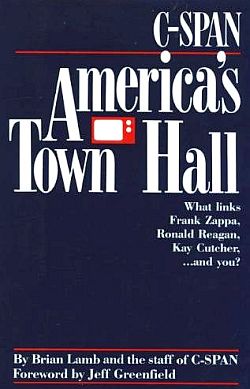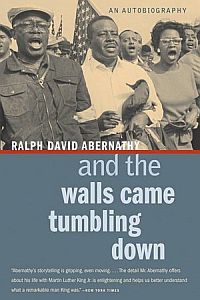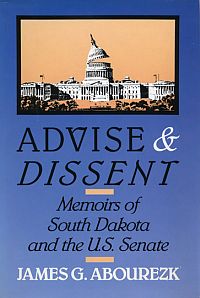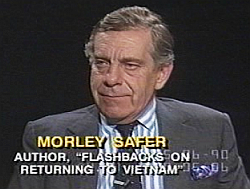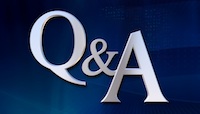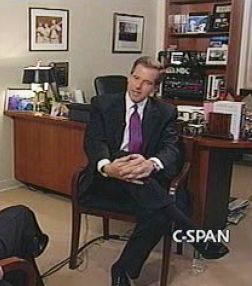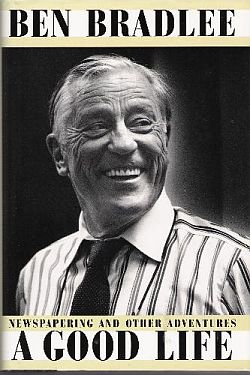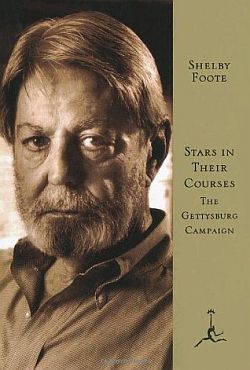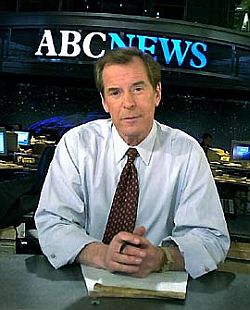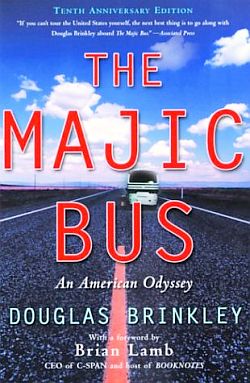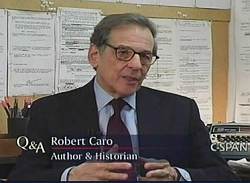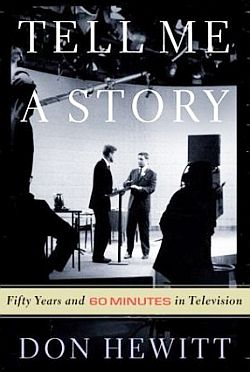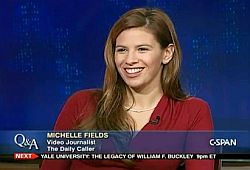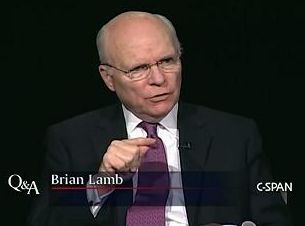
Brian Lamb, founder & creator of C-SPAN, also hosted the weekly “Booknotes” and “Q&A” shows at C-SPAN.
Lamb is part policy wonk, part activist, and part educator. Among other things, he’s a staunch believer in the public’s right to know, and that’s basically what led him to create C-SPAN.
He also holds a healthy disdain for power centers of any kind, especially those that might try to monopolize information or manipulate or twist the truth. And this too, figures into Lamb’s motivation for creating C-SPAN. More on that later. But in addition to his TV network-creating skills, Brian Lamb is also a guy who is forever curious; a guy whose enthusiasm for learning has become a Sunday-night staple for millions of C-SPAN viewers. Lamb is not the “star” of these shows, nor does he want to be, preferring to stay off camera. For more than two decades, Lamb has hosted hundreds of authors and power players in engaging one-hour sessions on his “Booknotes” and “Q&A” TV shows. All manner of topics are explored on these shows, most within the general orbit of public affairs and related cultural territory. Yet Lamb is not the “star” of these shows, nor does he want to be. Lamb prefers to stay in the background and ask the questions and is usually off camera. If anything, it is the content of these shows that is the “star;” Lamb revels in simply being the provider. Whether it’s the key moments of discovery from a famous author, the most challenging decisions of an American president, or the quirky strategies of a twenty-something Capitol Hill web videographer, Brian Lamb delights in bringing new information and new people into public view. His quiet enthusiasm and inquisitiveness on these shows, and others, has been contagious, as his viewers and fans will attest.
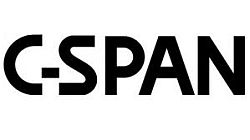
Early C-SPAN logo, which stands for the "Cable Satellite Public Affairs Network."

Brian Lamb in earlier clip from C-SPAN’s “Washington Journal,” where journalists, public policy makers & call-in audience discuss events of the day.
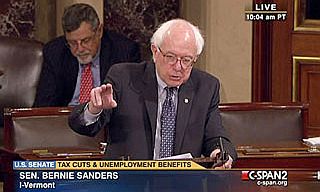
Typical scene on C-SPAN 2, here showing U.S. Senator Bernie Sanders (I-VT) making a point on the floor of the U.S. Senate in 2010.
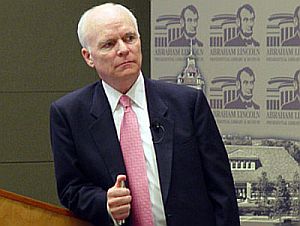
Brian Lamb at the Abraham Lincoln Presidential Library & Museum, Springfield, IL, April 2005.
Congress does, however, control the cameras in the main House and Senate chambers, a policy Lamb and C-SPAN have consistently sought to change.
As Lamb has explained elsewhere: “There are eight cameras in each chamber. They’re remote-controlled cameras. They’re operated in the basement of the Capitol. And we have nothing to say about this.”
The C-SPAN networks, meanwhile, have broadened their public affairs programming over the years, adding more depth and variety. At its core, however, C-SPAN is still focused on policy makers, government officials, journalists, editors, and others who work in and around the public policy process.
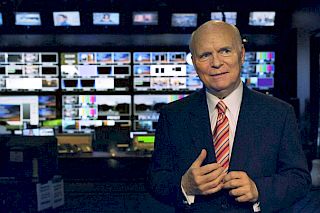
Brian Lamb in C-SPAN control room. In recent years, he has been mistaken for John Glenn or John McCain.
Much of what has become C-SPAN over the last three decades bears the stamp of Lamb. In his 34 years at the helm, Lamb has conducted over 1,000 interviews, taken thousands of phone calls from viewers, and discussed the issues of the day with leading authors, journalists and politicians. “…We’re the antithesis of everything you see on commercial television.”
– Brian Lamb He has interviewed every president since Lyndon Johnson and many world leaders such as Margaret Thatcher and Mikhail Gorbachev.
But one thing is for certain: neither Lamb nor C-SPAN are in it for the limelight. As Washington Post writer Paul Farhi noted of Lamb in March 2012 – that although he had appeared in thousands of hours of interviews and call-in programs, Lamb “has never once uttered his own name on the air. Too showy. Too much like regular TV…” Lamb and his people have avoided that kind of attention. “No one does that here,” Lamb explained to Farhi. “We just don’t do it. It’s always been part of our mission not to make us the center of attention…We’re the antithesis of everything you see on commercial television.” Nor does Lamb take credit for C-SPAN, typically deflecting personal kudos that come his way, pointing out that many others make it all possible.
Midwest Roots
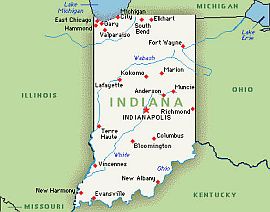
Brian Lamb was born and raised in Lafayette, Indiana, in the west-central part of the state.
“I think being from a small town, being from the middle of the country, being from a relatively small family with parents who were alive and alert but not heavily educated, being from an area where people allowed you to do anything you wanted to do–you could fail… If you succeeded, they didn’t overdo the praise. There was a great skepticism in the middle of the country about a lot of things, but yet there was a genuineness about it that you often don’t find on the two coasts. Everything I lived back in Lafayette, Indiana, has had a tremendous impact on what I’ve tried to do here….”

Brian Lamb at WASK radio.
Lamb at one point had set his sights on becoming an entertainer. After he began college at Purdue University, located in West Lafayette, Indiana, he did stints as a drummer in a few local bands while getting his degree. At Purdue, Lamb was also attuned to current events and national politics. In the spring of 1960, the university held mock political conventions in which Lamb participated. On the Democratic side, there were a number of candidates then vying for the presidency, still months away from the national convention that would formally nominate U.S. Senator John Kennedy as the nominee.
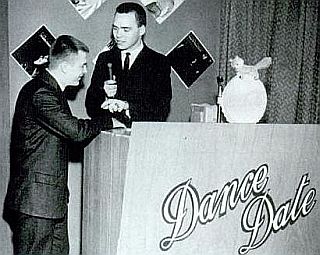 Early 1960s: Brian Lamb hosting his TV show, “Dance Date.” |
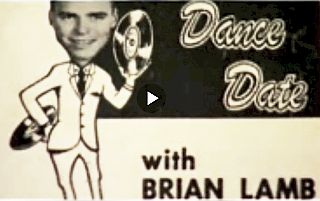 Early 1960s: Program card for the “Dance Date” TV show with Brian Lamb. Source: Cable Center video. |
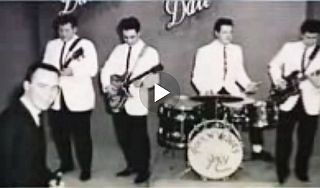 Early 1960s: Brian Lamb, left, with musical guests on “Dance Date” TV program. Cable Center video. |
Purdue students that spring nominated Kennedy, but as Lamb recalls: “It wasn’t just that we nominated Kennedy. It was also that we paired him with Lyndon Johnson, which no one nationally was doing at that early stage.” Lamb today remains an advocate of mock elections on college campuses, adding, “I learned so much by going through that process.”
By his junior year at Purdue in 1961-62, Lamb got a taste of the television business after he pitched an idea for an American Bandstand type TV dance show to a local station owner Dick Shively. Dick Clark’s American Band- stand had become a wildly popular show, which had gone national on the ABC- TV in August of 1957. “I loved Dick Clark and what he did with American Bandstand when I was a kid,” explained Lamb. “When you’re young you copy everybody else.”
Lamb titled his TV dance show, Dance Date, which he hosted. It was telecast weekday afternoons for a half-hour on a UHF station in Lafayette — WLFI, channel 19. But Lamb ran the whole show at Dance Date and he took responsibility well beyond just handling the microphone.
“I built the sets, hosted the show, got the dancers, sold it to advertisers,” he explained in one interview. “It was a very important experience.”
Some fans of the show remember Lamb holding up the Beatles’ first album and talking about the group during one of the shows, as this was the era when the Beatles’s music was first being introduced in the U.S. Brian Lamb’s television future, however, would be quite different from Dance Date.
Back at Purdue in 1963, meanwhile, Lamb finished his college education with a Bachelor’s degree in Speech. He thought about law school briefly, and actually attended class a few days in Bloomington at Indiana University, but then joined the Navy for four years.
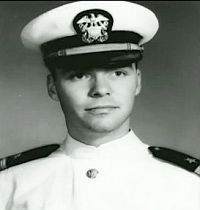 Naval officer, Brian Lamb, 1960s. |
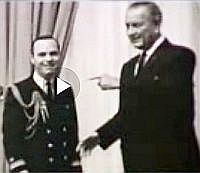 1960s: Naval officer Brian Lamb with President Lyndon B. Johnson. |
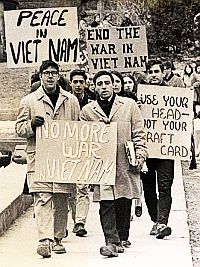 Student protest against Vietnam War in Madison ,Wisconsin, 1960s. |
Lamb’s tour in the Navy included two years at sea on the USS Thuban, and two years back in Washington, with time spent both at the Pentagon and at the White House as a social aide to President Lyndon Johnson. Among other duties there, Lamb would announce the names of visitors to the President so the President could then address each person by name as they were introduced.
One notable event for Lamb as White House social aide came in 1967 when he became the down-the-aisle escort for Lady Bird Johnson at the wedding of her daughter, Lynda Bird Johnson, to Chuck Robb.
But at the Pentagon’s public affairs office during those years, Lamb saw how the big broadcast news networks worked and got to know what news correspondents did. He noticed that while they all had different personalities and styles, they were basically covering the same stories. He also had other experiences at the Pentagon that contributed to his C-SPAN idea.
During the Vietnam War, a group of anti-war demonstrators had come to the Pentagon to protest, and they were given access to the building by Defense Secretary Robert McNamara in a show of goodwill. The group had spread itself across a corridor and gathered peacefully. Then an ABC News correspondent arrived and turned on the cameras.
As Lamb recalls: “These kids who had been quiet and serene stood up with their placards… What [television viewers] saw was not what was actually happening. They saw a minute-and-a-half story on the evening news. It was misleading. I said to myself, ‘It’s too bad the public can’t see the whole thing and let them make up their own mind.’”
C-SPAN coverage in later years would become known, in fact, for leaving the cameras on both before events convened and after they concluded, whether committee hearings or expert conclaves, so viewers could also get a taste for the milling around, and what was going on beyond the main event.
Another media-related experience Lamb had about the same time was when he went to hear a speech by civil rights leader Stokely Carmichael at a Baptist church in Washington, D.C. Lamb listened to the 30-minute speech by Carmichael and found it to be mostly thoughtful and intelligent. But NBC News that night telecast only a part of the speech.
“What made it on [the broadcast] was the fire and brimstone,” Lamb would later explain. During those years Lamb also had some exposure to urban unrest (see “The Detroit Riots” sidebar below).
At the Pentagon during the Vietnam War, Lamb also realized the public wasn’t getting the full truth about the war, and that the government was lying to the American people.
|
“The Detroit Riots” During Brian Lamb’s Navy hitch, when he worked in the Office of the Assistant Secretary of Defense for Public Affairs, he was sent on one assignment in the summer of 1967 which he later recalled in a longer interview: I was in the audiovisual office, which was responsible for staying in touch and answering queries by the networks: ABC, NBC, and CBS. In July of 1967, one of the deputy assistant secretaries came in and said to me, “Go home and pack your bag and take this tape recorder with you and fly to Detroit and report to the chief of police’s office.” “…Even though we were in the middle of the Vietnam War and I was in the military, I had never quite seen anything like this…” I’ll never forget it. There were race riots and forty-three blacks were killed in Detroit in July of 1967, and two hundred people were injured. I arrived in the city with, I think, the 82nd Airborne. There were tanks on the street corners. There were fatigues-wearing military people in the Cadillac Hilton, where we were all staying. It was a bit overwhelming. Even though we were in the middle of the Vietnam War and I was in the military, I had never quite seen anything like this. I reported for duty in this small room, and in that room were Cyrus Vance, the deputy secretary of defense at the time; Warren Christopher, who was the deputy attorney general; John Doar, who was then an assistant attorney general and who went on later to be the Watergate counsel; a man named Dan Henkin, who was the deputy assistant secretary of defense; and Roger Wilkins, who was the top civil rights man in the Justice Department; and me. |
“I got a firsthand education [during those Pentagon years] about how the media interacts with the government, and it led me to think that there could be a better way,” he would later say. Lamb was envisioning a kind of TV coverage that would have no censorship or manipulation by the government, but also no commentary from media pundits.
In December 1967, after his Navy hitch, Lamb interviewed for a job as a personal aide to Richard Nixon, who was then beginning his 1968 presidential campaign. But Lamb did not get the job – a good result as it turned out – and he returned briefly to local television work in Lafayette, Indiana.
|
“Nixon-Agnew Gig” In 1967, Brian Lamb was briefly a field representative in the Midwest for “United Citizens for Nixon-Agnew.” His main task was to tape record voter comments about political and social issues. At the end of each week the tapes were dispatched to Washington where the candidates would supposedly listen to them. “I was naive and gullible enough to think this was an honest effort,” Lamb would say in recalling his experience. “Later I was told all the tapes were edited down to an hour that Nixon and Agnew heard – which was a total lie.” After that, Lamb vowed that some day he would go back to the community and go on the street corner and ask people what they really thought about Nixon and Agnew. The experience also influenced his thinking on C-SPAN’s call-in programs, open to all citizen views, and have become one of C-SPAN’s strengths. But for Lamb, his 1967 stint wasn’t the end of his Nixon-Agnew experience. In 1986, at a roast for Walter Cronkite during the Society of Professional Journalists’ convention, CBS commentator Andy Rooney leveled some sarcastic comments at Lamb. “Rooney attacked me personally,” Lamb would later recall. “He said, ‘Brian Lamb worked for the Nixon-Agnew White House and we know what Nixon and Agnew thought of the First Amendment.”‘ Lamb is typically quick to point out that he has never been a member of a political party, nor has he ever contributed to any party. He does acknowledge his conservative heritage, however. “Certainly, being from Indiana I was not raised in a liberal environment.” |
But Lamb soon came back to Washington. There, he ran into Howard Baker, a young U.S. Senator from Tennessee who Lamb had met earlier at a White House social event. Baker helped Lamb find a short-term job in the Nixon-Agnew campaign, where Lamb spent ten weeks, including some time on the road in the Midwest (see sidebar).
Lamb then worked as a reporter for UPI radio, but in 1969 became press secretary for Republican Senator Peter H. Dominick of Colorado. Lamb had also been thinking about politics and cable TV, as he later relayed in an interview with the Cable Center: “I remember in 1969, before I went to work on Capitol Hill, that I wrote a letter to a friend of mine, Dick Shively, who used to own Telesis [cable system], which is based in Indiana. I remember proposing to him that we create a Washington bureau for cable television where we would do information and interviews. That was my way of throwing my oar in the water, saying this is something that this industry ought to do and something that I want to do.”
By 1971, Lamb was working as a media and congressional assistant to the director of the White House Office of Telecommunications Policy. This experience came at a time when a national strategy was being developed for reforming communications policy — policy that would open the doors to satellite and cable television, enabling a new competition with the big broadcast networks. Lamb had a front row seat to this policy development, and among others in that office, got to know Antonia Scalia, who was then general counsel for the Telecommunications Office, and with whom Lamb would later spar when Scalia rose to the U.S. Supreme Court where he objected to C-SPAN cameras.
After working in the White House telecommunications office, Lamb returned to journalism as the editor of his own biweekly newsletter called The Media Report. By May of 1974, he also began writing for CATV Weekly, a small cable industry magazine/newsletter. Lamb would later explain how important that job became in terms of getting to know key players in the fledgling cable TV industry:
By covering the new cable TV industry and inter- viewing its executives, Brian Lamb became a familiar face throughout the industry.
“…I remember Barbara [Ruger, editor] saying to me: ‘You come write for us, and we’ll put your picture in the column. You want to do this network that you’re talking about, this picture and this column in this little magazine…will introduce you to the industry.’ And it worked. It was the beginning of my introduction to the people in this business. Every week in the magazine I would go out and interview a leader, and I’d take their picture and we’d put it on the front page of the magazine. I would interview them, just like you’re doing right now. I’d transcribe it myself and we’d run the interview the next week in the magazine. I’d write my column with my picture on it. And it took a long time, but a couple years later everybody knew who I was in the business. And then I started to go to them and say what do you think about my idea for C-SPAN?”
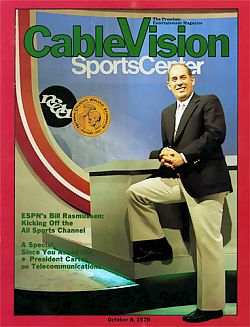
1970s: Brian Lamb became Washington bureau chief at Cablevision magazine. Sample cover, 1979.
Cable television at this time, at least in the mainstream sense, was in its very early stages. Home Box Office had started in 1975, the same year that RCA’s Satcom II satellite was launched and put into operation. In mid-December 1976, Ted Turner’s “superstation,” WTCG in Atlanta (later renamed WTBS), beamed its first signals via satellite to four cable providers beyond Atlanta. Turner’s Cable News Network – CNN – would not come into existence until June 1980. Lamb pitched “more interviews with members of Congress”–and longer interviews–something cable television could do. Only a few other systems were up and running in 1977. Pat Robertson had a channel in Portsmouth, Virginia and Bob Rosencrans had a Madison Square Garden offering of sporting events at night.
So when Lamb came to Mayflower to make his pitch in August 1977, he was springing his idea on a group that wasn’t quite ready for what he was proposing. As Lamb later recalled in a Cable Center interview: “…I said to the group, ‘My idea is that we figure out a way to do public affairs. That we do our own ‘Meet the Press’ type program, because cable has no identity with this. They’ve never done any public service.” Lamb told the group what he had in mind was “public affairs”and not news. “Not anchor people sitting at desks telling you what’s happening. More interviews with members of Congress — long-form interviews– something that cable television could do.”
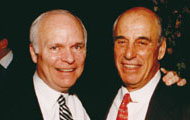
Brian Lamb in a later photograph with Bob Rosencrans.
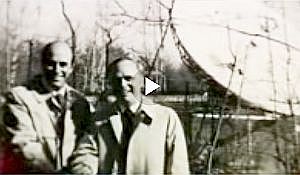
1970s: Bob Rosencrans & Brian Lamb near satellite dish for C-SPAN in early years. Cable Center video.
Although telecasts of opening sessions of Congress and presidential speeches to Congress had occurred from time to time dating to the late 1940s, Congress was generally cautious about incorporating television into its operations. In 1952, House Speaker Sam Rayburn banned TV coverage from regular floor sessions and com- mittee hearings. Occasionally, hearings such as the Kefauver Senate crime hearings of 1950-51 were broadcast. Yet in 1952, House Speaker Sam Rayburn banned TV coverage from regular floor sessions and committee hearings. But even with that, special circumstances, such as the Army-McCarthy hearings of 1954, would bring TV coverage. And in the mid-1970s,with the Watergate hearings and the prospect of impeachment proceedings against President Richard M. Nixon, the House authorized broadcast coverage of floor debate, which did not occur since Nixon resigned. Still, the 1974 network telecasts of the Senate Watergate hearings and House Judiciary Committee’s impeachment probe proved that Congressional TV watching could be compelling – though driven by extraordinary events in this case.

Tip O’Neill, Speaker of the House, was key in opening up Congress to C-SPAN in late 1970s.
In terms of opening up Congress to the TV cameras, Lamb gives O’Neill “150 percent credit for being the one that opened the doors.” O’Neill “took the barriers down,” says Lamb, and was the one guy who could also have stopped it in its tracks. But he didn’t. And the reason, in part, was politics. At the time, the U. S. Senate was getting all the attention in the media, or at least the lion’s share. And according to Lamb, “Tip O’Neill’s younger colleagues kept saying, ‘We’ve got to open this place up. If we don’t…, we’re going to be forgotten.’ And so Tip O’Neill eventually said, ‘OK, I’m ready, let’s go’.”
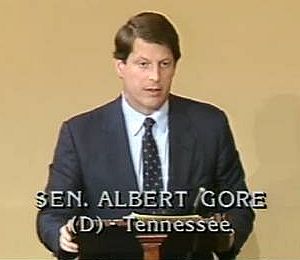
Al Gore, Democrat of Tennessee, had the distinction of delivering the first C-SPAN speeches in both the House, March 19, 1979, and, shown here, in the Senate on June 2, 1986.
They shared the space with Cablevision magazine in a building that initially had no cable reception. They had one phone line in those days and would later share satellite access with Bob Rosencrans’ Madison Square Garden sports shows, as C-SPAN programs were sometimes bumped to make room for professional wrestling.
But in March 1979, C-SPAN sent out its first live views of a U.S. House of Representatives session to its network – then some 3.5 million homes served by 350 cable systems. At that time, only about 19 percent of American homes were wired for cable TV.
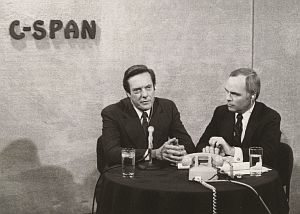 Brian Lamb with Republican National Committee chairman, Bill Brock on C-SPAN, 1979. |
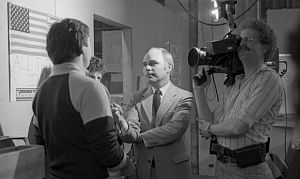 1980: Brian Lamb at Sen. Edward Kennedy’s campaign offices in Philadelphia, PA. Photo: Cable Center |
 Brian Lamb, far right, hosting C-SPAN’s first viewer call-in show at the National Press Club, October 1980. |
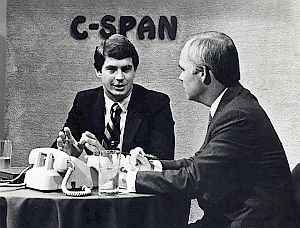 Brian Lamb, right, interviews former Oklahoma Rep. Dave McCurdy on early C-SPAN set. AP photo. |
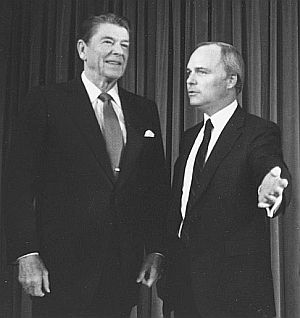 1981: Brian Lamb with President Ronald Reagan. |
First Speech
The first U.S. House of Representatives speech C-SPAN sent out to its cable viewers came from a 30-year-old, second-term congressman from Tennessee named Al Gore. Speaking from the members’ front-and-center podium on the House floor, Gore made note of the historic event: “The marriage of this medium and of our open debate have the potential, Mr. Speaker, to revitalize representative democracy.” Gore further praised the coming of television to Congress as “a solution for the lack of confidence in government,” also adding that “television will change this institution.”
Once the House cameras were rolling, Lamb and C-SPAN would turn their attention to the Senate, but that would entail a much longer fight. In the meantime, other kinds of public affairs programming were pursued, including one-on-one interviews with members of Congress, coverage of speeches from the National Press Club, the beginning of call-in shows involving C-SPAN viewers, and early political campaign coverage.
In the early days, Lamb worked from a small table and a basic set, with room divider behind him as he interviewed politicians. In the first photo at right, Lamb is interviewing Republican Bill Brock from Tennessee , believed to be from 1979 when Brock chaired the Republican National Committee (RNC). Brock had served in the House from 1963-1971, the U.S. Senate through 1977, RNC chairman 1977-1981, U.S. Trade Representative (1981-1985), and was appointed Sec. of Labor by President Reagan 1985-1987.
By early 1980, the first National Press Club speech covered by C-SPAN was that by Paul Volcker, chairman of the Federal Reserve Board. By then, C-SPAN had also begun some public education activity, such as its student seminars with the Close-Up Foundation, which brings high school students to Washington to meet with politicians and government officials.
Lamb and C-SPAN also began tracking political campaign activity outside of Washington. In the summer of 1980, for example, Lamb interviewed campaign workers at Senator Edward Kennedy’s campaign headquarters in Philadelphia, as Kennedy was them mounting a nomination challenge to incumbent president Jimmy Carter.
Also in 1980, C-SPAN began a series it called “A Day in The Life,” a program that followed a day’s worth of activity of someone who worked in politics, journalism, or public affairs. The first offering in this series came in October 1980 following Larry King, who then had a radio show with Mutual Radio – before he became a TV personality. The first federal agency hearing was also covered by C-SPAN around this time.
On October 7, 1980, Lamb and C-SPAN broadcast their first call-in show from the National Press Club, the beginning of what became the three-hour morning show known as “Washington Journal.” On that show, Lamb and his staff adopted a standard for themselves to make sure they took 50 to 60 calls during that program, to make sure the program stayed faithful to being a place where average people to ask questions of policy makers and offer their own views. The 50-to-60 calls rule was also used to discourage show hosts from talking too much. Lamb also hosted a Saturday morning round table with two or three Washington journalists, which was also open to viewer call-ins.
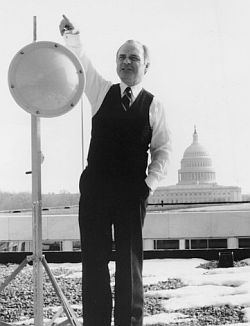
Brian Lamb, jack-of-all trades, on C-SPAN rooftop with antenna, wintry day, 1983. Photo, Cable Center.
In February 1984, C-SPAN also covered for the first time ever, an Iowa caucus event live and uninterrupted. In July and August that year it offered, also for the first time, full, live and uninterrupted coverage of the Democratic and Republican National Conventions. Back in the House, meanwhile, members of Congress were beginning to learn how to use C-SPAN to their advantage, with some making speeches that would be aired and taped for later use in their home districts or in campaigning. And some members also used the TV cameras to build a following beyond their own districts.
“C-SPAN Star”
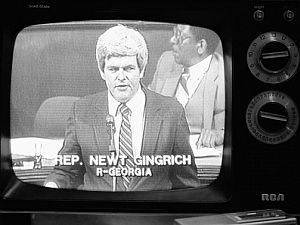
1984: Rep. Newt Gingrich (R-GA), a rising young Congressman, used C-SPAN to enhance his career.
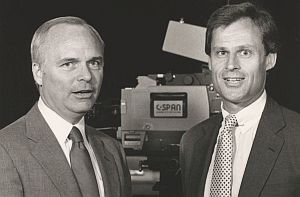
August 1985: Brian Lamb, C-SPAN Chairman & CEO, with Paul Fitzpatrick, President.
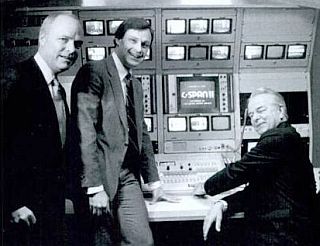
Brian Lamb at left with Sen. Robert Byrd (D-WV), far right, flipping the switch for C-SPAN 2 on June 2, 1986. Paul Fitzpatrick, center, was then president of C-SPAN.
The photo at right shows C-SPAN founder Brian Lamb at left with Sen. Robert Byrd (D-WV) far right flipping the switch for C-SPAN2, on June 2, 1986. In the middle is Paul Fitzpatrick, then-president of C-SPAN. As he had done in the House, now U.S. Senator Al Gore (D-TN) made the first televised floor speech. On July 29, 1986 the Senate voted in favor of permanent televised coverage of its proceedings. By January 1987, C-SPAN 2 was offering 24-hours of programming.
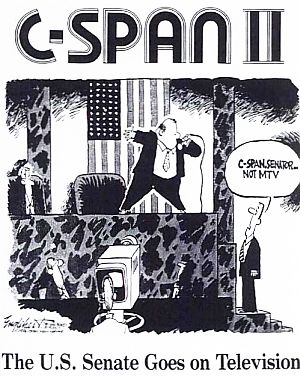
1986 cartoon from Connecticut’s “Hartford Courant” newspaper on C-SPAN coming to the U.S. Senate.
With the coming of television in the Senate, there were fears that some members would resort to theatrical performances or engage in “grandstanding,” and a few in the media poked fun at the Senate. The cartoon at left appeared in Connecticut’s Hartford Courant newspaper. It shows a Senator dancing on Senate President’s desk, as an advisor or colleague off to the side reminds him, “C-SPAN Senator, Not MTV.” In the mid-1980s, the popular “Music TV” or MTV cable channel was known for its rock music videos. The members of the U.S. Senate, however, maintained their decorum, even with the cameras. Generally, the presence of cameras improved the level of debate. Members used more visual material – charts, graphs, enlarged newspaper stories, etc – during their remarks. But to be sure, there was a share of “playing to the cameras” and Senators using the medium for their own political purposes, as members on the House side were doing. Elsewhere in Washington, C-SPAN helped change the nature of work for lobbyists, journalists and others who worked in and around Congress. Lobbyists could now monitor what was going from their offices by staying tuned to C-SPAN and C-SPAN 2. Journalists could also follow floor action via C-SPAN for breaking news on legislative stories. C-SPAN coverage of Congressional hearings could also draw a crowd, depending on topic. In 1987, the Iran-Contra hearings, which covered a military-arms-for-hostages scandal implicating senior Reagan Adminstration officials and the routing of funds to support Nicaraguan Contra fighters, drew in many new C-SPAN viewers.
But C-SPAN by the mid-1980s had become more that just a televised window on House and Seante proceedings, as its coverage and public affairs programming reached out to more venues. In July 1987, for example, C-SPAN Classroom was launched, an expansion of C-SPAN’s outreach in public education.Brian Lamb and other C-SPAN hosts by this date were also doing dozens of interviews with journalists, historians, TV producers, and other professionals involved with public policy and public affairs. In January 1988, for example, Lamb interviewed Jeff Greenfield, an ABC TV analyst who covered politics, and also author Gail Sheehy, a contributing editor for Vanity Fair magazine who had written about the 1988 presidential candidates. These interviews were part of a C-SPAN series profiling New York city’s political and communications leaders.
Also in 1988, Brain Lamb, Susan Swain, and the C-SPAN staff published the first book about their network. Titled America’s Town Hall, the book’s subtitle asked: “What Links Frank Zappa, Ronald Reagan and Kay Cutcher… and You?” Answer: they all watch C-SPAN. The book, in fact, was a “who-watches-us” assessment of the network at its ten-year mark. It was also C-SPAN “taking stock” of its operation, using profiles of 100 or so famous and no-so-famous viewers, why they watched, what they liked, etc. Among C-SPAN viewers profiled in the book were the three mentioned in the subtitle – Frank Zappa, then a controversial rock musician; U.S. President Ronald Reagan; and Kay Cutcher an Iowa activist. Among others included were former Congressman and civil rights leader, Andrew Young; TV talk show host Phil Donahue; Congressman Dick Armey (R-TX); Princeton basketball coach Pete Carril; U.S. Senator Howard Baker (R-TN); U.S. Naval Academy political science professor Stephen Frantzich; U.S. Congressman Newt Gingrich (R-GA); “Friends of C-SPAN” activist Shirley Rossi; and others. These and other viewers offered accounts of why they liked C-SPAN or how its programming figured into their work or other activities. The title for America’s Town Hall came from a speech that Congressman Jim Wright(D-TX) had given praising the network, saying Lamb and staff had created “a town hall for the nation.” At the book’s release, Lamb and other panelists convened at the Washington Metropolitan Cable Club to introduce it, along with a short video by C-SPAN staff explaining the book’s content and characters, all of which is available at C-SPAN today (see Sources).Booknotes
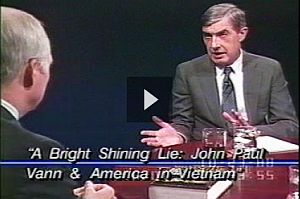
Brian Lamb’s five-part interview with Neil Sheehan, author of “A Bright Shining Lie,” the beginning of what became C-SPAN’s “Booknotes” TV series. Click for Amazon book link.
Lamb began hosting Booknotes in April 1989 as a regular Sunday evening show featuring non-fiction books and their authors. He would interview each author for an uninterrupted hour – “one book, one author, one hour,” is how he would sometimes describe his show. The set was simple: black background, two chairs, coffee table, two cups. Lamb asked basic questions: “Why did you write this?” “Where do you do your writing?” or “What caused you to take that approach?” Lamb’s formula on this and other C-SPAN shows was simple: “stay out of the way” and let the author give full and complete answers without interruption. What Lamb did on these shows was carefully listen to his guest, sometimes formulating next questions on the what the guest offered in reply. Substance and style were both covered, and viewers rarely went away disappointed.
Talking with National Endowment for the Humanities chairman Bruce Cole in 2003, Lamb allowed a peek into how reading and books got hold of him a few years prior to the creation of Booknotes:
…Until I was about forty-five I usually read the mass circulation books that everybody was talking about. I remember reading a book by Stewart Alsop and was intrigued by him, and there were some others. But Tom Wolfe’s book, Bonfire of the Vanities [1987], to me was just so real. I remember getting up in the middle of the night to finish it. In 1986 Warren Burger [the chief justice of the United States] had introduced me to a book called Miracle in Philadelphia, by Catherine Drinker Bowen. I was a member of a committee that Warren Burger headed on the bicentennial of the Constitution. He handed everybody this book, and I read it, and I loved it. [Bowen] was able to write about the Constitutional Convention in a way that I could understand. I just have gone crazy ever since then. I can’t explain it…
Books & Authors
The first Booknotes program on April 2, 1989 featured former President Jimmy Carter’s national security adviser, Dr. Zbigniew Brzezinski, talking about his book, The Grand Failure: The Birth and Death of Communism in the Twentieth Century. Here’s a sampling of some of the other authors and books from Booknotes’ first year:
Sunday, May 7, 1989
Col. David Hackworth, About Face: The Odyssey of an American Warrior.
Sunday, June 4, 1989
James MacGregor Burns, The Crosswinds of Freedom.
Sunday, June 18, 1989
U. S. Senator Robert Byrd, The Senate: 1789-1989.
Sunday, June 25, 1989
Elizabeth Colton, The Jackson Phenomenon: The Man, The Power, The Message.
Sunday, July 23, 1989
Jeanne Simon, Codename: Scarlett—Life on the Campaign Trail by the Wife of a Presidential Candidate.
Sunday, August 27, 1989
Jack Germond, Jules Witcover, Whose Broad Stripes & Bright Stars—The Trivial Pursuit of the Presidency 1988.
Sunday, September 10, 1989
Thomas Friedman, From Beirut to Jerusalem.
Sunday, October 15, 1989
Harrison Salisbury, Tiananmen Diary: Thirteen Days in June.
Sunday, October 29, 1989
Rev. Ralph David Abernathy, And the Walls Came Tumbling Down
Sunday, November 19, 1989
Robin Wright, In the Name of God: The Khomeini Decade.
Sunday, March 25, 1990
Former U.S. Senator James Abourezk, Advise and Dissent: Memoirs of South Dakota and the U.S. Senate.
Sunday, May 6, 1990
Morley Safer, Flashbacks On Returning to Vietnam.
Booknotes, of course, wasn’t all Lamb did. He still had time for other interviews, some under the rubric: “The Life and Career of…[xyz]” In June 1989, for example, he interviewed Eric Sevareid, the veteran broadcast journalist who had worked at CBS since 1939, an original member of Edward R. Murrow’s news team. “The Life and Career of Howard K. Smith,” an ABC newsman, was another in this vein. Booknotes, in any case, would become one of C-SPAN’s most important shows, and one where C-SPAN’s audience became most familiar with Brian Lamb and his style. The show would run for more than 15 years and involve some 800 interviews. More on Booknotes and its C-SPAN progeny a bit later; now back to C-SPAN’s history in the 1990s.
Expanding Audience

June 1990: Brian Lamb & John J. Rigas of Adelphi Communications, Inc., celebrating C-SPAN’s 50 millionth household. Cable Center photo.
C-SPAN continued to break new ground with its programming. In 1990-91, it gained notice for attaching lapel microphones to campaigning presidential candidates, following them around for hours at a time, documenting both the drama and mundane nature of running for office. In early 1991, with the outbreak of Gulf War, C-SPAN 2 reported a spike of 9.3 million new subscribers and the addition of 240 cable systems as congressional debate on the use of military force began.
By 1992, it began covering its fourth presidential campaign, then reaching some 55 million cable households. Established journalists in Washington by then were singing its praises. The late Tim Russert, former NBC Vice President and Bureau Chief called C-SPAN “the video resource of record.” Chuck Lewis, then Washington Bureau Chief of Hearst newspapers, praised C-SPAN as a “terrific concept that brings us ‘inside-the-Beltway’ types smack into reality with the public outside of Washington.” C-SPAN also took its show on the road in 1993, launching the C-SPAN bus with a production team that would travel the country, covering local events, visiting schools and more, generating local press as it did.
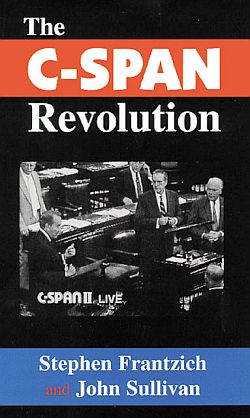
1996: One of the first books exploring C-SPAN’s creation and impact is published, “The C-SPAN Revolution,” by Stephen Frantzich and John Sullivan. Click for book at Amazon.
In October 1996, one of the first outside books on the C-SPAN experience appeared – The C-SPAN Revolution – written by Stephen Frantzich and John Sullivan, which examines the history and inside politics of setting up C-SPAN on Capitol Hill, how that coverage affected the inside-the-beltway game of politics, as well as the relationship with voters and those beyond Washington. C-SPAN by the mid-1990s had become the national public affairs network that Lamb had envisioned from the start. Its Booknotes and history components, among others, were also substantial elements by then. In 1998, Lamb would explain that House and Senate floor debate then amounted to “between ten and fifteen percent of what C-SPAN offers…in a year’s time.” He also noted, “we own 45 cameras, and now we go all over the world, showing different events … in the public affairs arena, not in the news business.” C-SPAN, he emphasized was “not in the news business and never wanted to be in the news business,” as there were lots of people in the news business. “There’s no one else in public affairs business,” he said.
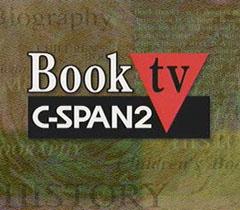
In September 1998, “Book TV” was added to C-SPAN 2 to provide more book-related programming. Click to visit BookTV.org.
…Well, there are a number of reasons… One, there was the word-of-mouth success of Booknotes, then a five-hour-a-week edition a couple years ago called “About Books,” and then the full 48 hours of Book TV. There was not much more thought given to it than that. People just liked it. We got a lot of feedback from it.
Secondly, …there is a $25 billion-a-year business in the book industry. There are over 1,000 superstores and 13,000 independent bookstores in the United States. It matters out there to somebody, and nobody else is doing anything more than short spots on television…
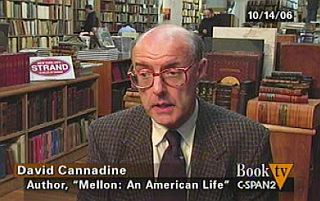
Oct 2006: Author David Cannadine appeared on C-SPAN’s “Book TV” from the Strand Book Store in New York City for his biography, “Mellon: An American Life.” Click to view.
In mid-January 2001, for example, Nick Mangieri, a 72 year-old self-published author with two autobiographical books about his days as a crusading cop – Broken Badge and Frozen Shield – appeared at a Barnes & Noble store in Newport News, Virginia for a book discussion covered by C-SPAN. Hundreds of other authors have appeared on BookTV programs at bookstores throughout the country.
C-SPAN also created other programming in 1999, launching its “American Presidents” series in March that year, a series with three-hour treatments of each of the nation’s 41 presidents. Aaron Barnhart of the Knight Ridder/Tribune news group wrote of that show: “If you want to catch TV’s most captivating series this summer, don’t look to HBO. Don’t look to MTV. Look to C-SPAN[’s]… ‘American Presidents: Life Portraits.’” Aside from its obvious value to history buffs, Barnhart observed, “what makes ‘American Presidents’ so compelling are the unexpected, often contentious debates that take place between the program’s featured historians and its viewers who call in and offer very different takes on the American presidents….”
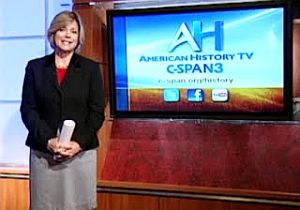
C-SPAN executive v.p., Susan Swain, shown hosting a C-SPAN 3 “American History TV” program.
Booknotes End
Brian Lamb, meanwhile, was still going strong with his one-on-one author interviews at Booknotes. By December 2004, however, he decided to end that program and try something different. Through 15 years of Booknotes, however, Lamb had rendered something of an Iron Man, Lou Gehrig performance, reading 800 books, most on his own time, and never missing a single Sunday night, for 52 weeks every one of those years. His guests had ranged from Dr. Cornel West, to former President Richard Nixon, New York Times columnist, Maureen Dowd, and many others. Brian Lamb’s Booknotes program, which ran for 15 years, has been described fondly as “a little piece of television sanity.” Guest authors weren’t determined by complicated formula, but rather by Lamb’s belief they would be of interest to his audience, have something novel to say, or have insight or information the public should know about. Lamb avoided celebrity-type books on his show, believing them to be commercially motivated, and also covered extensively elsewhere. Politicians who wrote books, or had them ghost written, were also avoided, as these were seen as campaign vehicles. Lamb’s fans, meanwhile, would describe his Booknotes show as “a little piece of television sanity.” His interview method was guided by the basic journalism questions of who, what, when, where, why and how. He would also ask his author guests: How do you work?, Where do your work?, Who are your influences?, and others in that vein. His goal was to give the author plenty of time and room to answer – and keep himself out of the picture. Most of a Booknotes hour was filled with the author talking, not Lamb.
After Booknotes ended, Lamb began hosting a new program titled “Q&A,” which featured interviews with notable figures from politics, technology, education, and the media, as well as authors and historians. Q&A premiered in mid-December 2004. Among early guests were Fox News president Roger Ailes, NBC Nightly News anchor Brian Williams, and Rensselaer Polytechnic Institute president Shirley Ann Jackson. Other guests have included former Arkansas Governor Mike Huckabee, Wikipedia co-founder Jimmy Wales, former CIA Director Michael V. Hayden, and others. When it comes to his Q&A guests, Lamb follows his instincts mostly, just as he did with Booknotes.
In his Q&A session with Brian Williams, C-SPAN cameras went to the NBC Studios in Rockefeller Center for the show. Williams was interviewed two days before he was to begin as anchor of NBC News following the retirement of Tom Brokaw. With Lamb asking the questions, Williams talked about his childhood, his early interest in politics and history, and his collection of political memorabilia, and that like Lamb, he had an interest in presidential history and was writing a book about the death of President Garfield. During the interview, Williams also discussed his internship in the Carter White House, his political leanings, his love of books, and the rigors of the thirty-minute television news show.Lamb’s guests on his Q&A show were not then, and still to this writing, all well-known faces like Williams, as he continued seeking out those with novel stories. In 2006, for example, he interviewed Adonal Foyle, a basketball player with San Francisco’s Golden State Warriors. Foyle also happened to be an interesting America political player, though not in the conventional sense. He is the founder, President, and primary funder of Democracy Matters, a nonprofit foundation that focuses on grass-roots, pro-democracy reforms. But Foyle is also a native of the Caribbean island of St. Vincent, can’t vote in America. Still, his foundation focuses on increasing voter participation and leveling America’s political playing field. Foyle has spent millions of his own money on the foundation, part of his effort to return the favor of his good fortune in America. That’s the kind of guest Lamb loves to have on his show, an outsider tweaking the power centers.
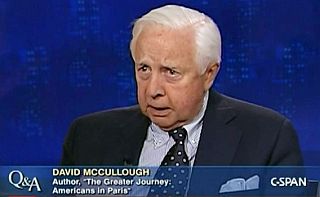
Historian David McCullough being interviewed on “Q&A,” May 2011, for his book, “The Greater Journey.” Click to view.

U.S. News & World Report caricature of Brian Lamb seeking Supreme Court access.
In its own shop, however, C-SPAN has been attuned to the web and the use of the social media. In 2007, it changed its copyright policy to allow online posting of its videos. In 2009, Twitter users began submitting questions live to C-SPAN programs. In January 2011, C-SPAN’s Facebook page added live streaming.
Kudos for Brian
Brian Lamb has been collecting kudos for sometime now – from serious readers, policy analysts, media pundits, politicians, publishers, and just plain old everyday folks who have acknowledged his contribution to their better-informed worlds. Lamb has received all manner of awards and honors: the National Press Club’s Fourth Estate Award in 2002; the National Humanities Medal, the Harry S. Truman Good Neighbor Award, and The Media Institute’s Freedom of Speech Award – all in 2003; the Theodore Roosevelt-Woodrow Wilson Award in 2004 from the American Historical Association–this one “for extraordinary contributions to the study, teaching, and public understanding of history.” In November 2007 at the White House, with President George Bush doing the honors, he received the Medal of Freedom, the highest civilian award in the United States. The Medal’s citation reads in part: “…As the driving force behind the creation of C-SPAN, Brian Lamb has elevated our public debate and helped open up our government to citizens across the Nation….”

Stephen Frantzich’s 2008 biography, “Founding Father: How C-SPAN’s Brian Lamb Changed Politics in America.” Click for book at Amazon.
His alma mater, Purdue University, was one of the first to recognized him back in the mid-1980s with an honorary degree. Purdue also awarded him its Distinguished Alumni Award in 1987, and he has returned there occasionally for other events. In April 2011, Purdue’s communications department was renamed the Brian Lamb School of Communication. That fall, as part of the establishment of that new center, Lamb also did a Q&A session with Indiana Governor Mitch Daniels at the university.
In October 2011, Lamb received the Al Neuharth Award for Excellence in the Media at a ceremony in South Dakota. Al Neuharth, founder of USA Today and the Freedom Foundation, and making the award, said in part: “For three decades, Brian Lamb and his colleagues have pulled back the curtain on our democratic system, resulting in a more informed electorate … The C-SPAN networks, created under Brian Lamb’s leadership, allow millions of interested citizens to be watchdogs of Washington through the fair, unfiltered and comprehensive coverage of government and the political process.”
|
“The Lamb Collection” 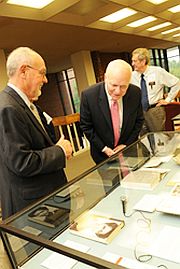 Brian Lamb taking a look at his own “book notes” at George Mason University exhibit. The Brian P. Lamb Booknotes Collection at the George Mason University Libraries contains the full set of the 801 books that Lamb read for his author interviews on the Booknotes show. The university celebrated the new acquisition with an exhibit and reception on September 21st, 2011. The exhibit, “Beyond the Book: An Exhibition of the Brian Lamb Booknotes Collection,” displayed a selection of the books showing their marginalia along with other interesting items found in the collection, as well as selected excerpts from Lamb’s interviews with various authors. The goal of the exhibit is to capture Lamb’s engagement with the books and the content of the interviews rathern than highlight the content of specific books. “What is so unique about this collection,” according to the George Mason Libraries’ description, “is that it lends insight into how Lamb structured his interviews and interpreted the different works. It’s truly a valuable resource for students and researchers who conduct interviews themselves.” A digital component of the exhibit can be viewed online. |
In March 2012, when Lamb announced he was stepping down as CEO, there came a new round of praise, some of it quite thoughtful. Susan Milligan, a journalist at U.S. News & World Report, who in the early days, prior to internet and the 24/7 news cycle, remembered Lamb hosting weekly journalist roundtables, and how at 7:00 am on a Saturday he had already read a number of newspapers, including those of his journalist guests. But Milligan also noted how Lamb handled call-in viewers and the respectful tone he set:
Brian Lamb, professional, informed, and courteous, was a big part of the reason for the demeanor of the callers. Bipartisan doesn’t even begin to describe his approach. He listened to everyone, didn’t goad or insult viewers, and had the nonjudgmental expression that must have made him a phenomenal poker player….
Television news—or news and commentary—has acquired an aggressive and combative tone in our Attention Deficit Disorder political culture. Public relations officers at think tanks will report that their knowledgeable and erudite guests are not welcome on cable TV unless they are willing to get into a verbal joust with someone. The dialogue becomes less about the details of an issue and more of a Sharks versus Jets standoff, where the “liberal” or “conservative” moniker is assigned to a position not based on the substance itself, but on the people who espouse it. It reduces serious matters to cheap personality conflicts…
Brian Lamb and his network have never given in to that kind of marketing…
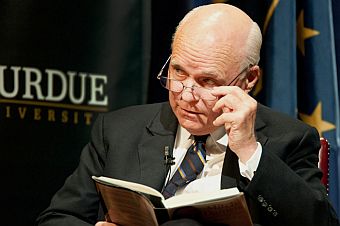
Brian Lamb at Purdue University during "Q&A" interview with Indiana Gov. Mitch Daniels, Sept 2011. Click to view video.
It is clear that America is much better off for having had Brian Lamb of Lafayette, Indiana come to work in Washington, D.C. He became, in one sense, the Frank Capra/public affairs version of “Mr Smith Goes To Washington” – but in this case, the real thing, not the film version. If you’ve never seen one of Brian Lamb’s programs, his shows are all available in the C-SPAN archive. (Note: Since this story was written, Brian Lamb retired from his CEO position and Q&A show at C-SPAN).
For more stories at this website on Media & Society or Politics, please visit those category pages for thumbnail sketches of posted stories, or see the Home Page for additional choices. Thanks for visiting — and if you like what you find here, please make a donation to help support the research, writing, and continued publication of this website. Thank you. – Jack Doyle.
|
Please Support Thank You |
____________________________________
Date Posted: 30 April 2012
Last Update: 12 October 2021
Comments to: jdoyle@pophistorydig.com
Article Citation:
Jack Doyle, “Brian’s Song: C-SPAN,”
PopHistoryDig.com, April 30, 2012.
____________________________________
Sources, Links & Additional Information
Jim Keller, “Brian Lamb Interview,” The Hauser Oral and Video History Collection, CableCenter.org, Au- gust 26, 1998.
Bruce Cole, “Changing the Channel: A Conversation with Brian Lamb,” Humanities (National Endow-ment for the Humanities), March / April 2003, Volume 24/Number 2.
“C-SPAN Milestones,” C-Span.org.
“C-SPAN’s Booknotes: Television’s Longest-Running Book Program,” Booknotes.org.
John Sullivan, “Brian Lamb: U.S. Media Executive, Founder of C-SPAN,” Encyclopedia of Television, Vol. 1, 2004, pp. 1305-1307.
“C-SPAN,” Wikipedia.org.
“Brian Lamb & C-SPAN Video,” Cable Hall of Fame Video, at CableCenter.org.
David Crook, “A One-Man Campaign for C-SPAN,” Los Angeles Times, May 11, 1982, p. H-1.
David Crook, “Video File: Brian Lamb Is Bullish on Outlook for C-SPAN; He Wants Network to Be a Neutral Conduit Between the Governing and the Governed,” Los Angeles Times, June 21, 1983, p. G-1.
T.R. Reid, “Congress: Best Little Soap Opera on Cable,” Washington Post, April 29, 1984, p. B-1.
“Profile of C-SPAN Book America’s Town Hall,” Brian Lamb and Panel at Washington Metropolitan Cable Club, Discussing Book (includes 7 minute staff video on book’s content and compilation), C-SpanVideo.org, June 22, 1988.
Lou Prato, “The Man Behind C-SPAN,” American Journalism Review, September 1992.
Lou Prato, “Politics In the Raw,” American Journalism Review, September 1992.
Neil MacNeil, “Tip Topped!,” Time, May 28, 1984.
John Herbers, “The World According to C-Span,” New York Times, Tuesday, August 13, 1985, p. B-6.
Russell Baker, Observer; “The C-Span Miracle,” New York Times, October 29, 1994.
James J. Unger, “A Conversation with Brian Lamb,” June 1995.
“C-SPAN Founder Says His Network Is Based on ‘A Simple Concept’,” Columbia University Record, October 27, 1995, Vol. 21, No. 8.
Stephen Frantzich and John Sullivan, The C-SPAN Revolution, University of Oklahoma Press, October 1996, 448 pp.
Elizabeth Taylor, The Chat Room, “The Cult Of No Personality; Talking With Brian Lamb, Master Of The Unobtrusive Interview,” Chicago Tribune, August 17, 1997.
Joe Klein, The Political Scene, “The Town That Ate Itself,” The New Yorker, November 23, 1998.
Brian Lamb, Booknotes: America’s Finest Authors on Reading, Writing, and the Power of Ideas, New York: Times Books, 1998.
Michael H. Ebner, “Bringing Democracy to Television” (Interview With Brian Lamb), Organization of American Historians, Indiana.edu, June 1999.
“Newt Gingrich: Rise to Power,” C-SPAN (with Eleanor Clift and Rep. Robert Walker), July 30, 1999.
“C-SPAN Founder and CEO, Brian Lamb,” Live On-Line, WashingtonPost.com, Thursday, April 20, 2000.
Brian Lamb, Booknotes Life Stories: Notable Biographers on the People Who Shaped America, New York: Times Books, 2000.
Mark Leibovich, “Brian Lamb’s Flock: The Unassuming C-SPAN Founder and Host Has a Faithful Audience,” Washington Post, July 11, 2002, p. C-1.
Brian Lamb, Booknotes: Stories From American History, New York: Penguin, 2002, 576 pp.
Brian Lamb and Richard Norton Smith, Who’s Buried in Grant’s Tomb? A Tour of Presidential Gravesites, Johns Hopkins University Press, 2003.
Rob Armstrong, “A Conversation with Brian Lamb,” in Covering Politics: A Handbook for Journalists, John Wiley & Sons, 2004.
Matthew May, “Reality TV,” American Thinker.com, August 12, 2004.
“The Last Booknotes”(C-SPAN video on the process of creating a Booknotes TV program, including comments throughout by Brian Lamb; scroll to bottom of page for video) Booknotes.org, October 27, 2004.
“Q & A,” Past Programs, By Date and Guest, Q-and-A.org, 2004-2012.
“Abraham Lincoln Presidential Museum,” ScholarWorks.GVSU.edu, May 2005.
Kane Citizen, “C-Span’s 25 Years of Call-In Shows,” NewsOnTheMarch.Blogspot, Saturday, October 8, 2005
Brian Lamb, Booknotes: On American Character, New York: Public Affairs, 2005.
The White House, “President Bush Honors Medal of Freedom Recipients,” November 5, 2007.
Stephen E. Frantzich, Founding Father: How C-SPAN’s Brian Lamb Changed Politics in America, Rowman & Littlefield, Publishers, 2008.
Ronald Kessler, “C-SPAN’s Lamb: Americans Feel Manipulated,” Newsmax.com, January 30, 2008.
Guest: Brian Lamb, “Inside Media: C-SPAN on the Air,” Newseum.org, May 25, 2008.
Brian Lamb and Susan Swain, Abraham Lincoln: Great American Historians on Our Sixteenth President, New York: PublicAffairs, 2008.
Patrick Gavin, “Lamb’s C-SPAN Turns 30” (Audio interview), Politico.com, March 25,2009.
Bob Titsch Interview at 30th Anniversary of C-SPAN,” C-SPAN Video Library, April 9, 2009.
Paul Bedard, Washington Whispers, “Even at 67, C-SPAN Boss Brian Lamb Isn’t Slowing Down,” U.S.News.com, April 11, 2009.
Bob Kemper, “Brian Lamb: An Outsider Inside Washington,” WashingtonExaminer.com, May 2009.
Andrew Malcolm, “C-SPAN pleads with Reid, Pelosi to open final drafting sessions for Obama’s healthcare bill (Updated), Los Angeles Times, January 5, 2010
Andrew Malcolm, “C-SPAN: this Program Lasts 31 Years, with No End in Sight,” Los Angles Times, March 16, 2010.
Nick Gillespie “The Democratizer,” Reason.com, December 2010.
Brian Lamb and Susan Swain, The Supreme Court: A C-SPAN Book, Featuring the Justices in Their Own Words, New York: PublicAffairs, 2010.
Maura Pierce, “Access Maker,” Think Magazine, Purdue University, Spring 2011.
“C-SPAN Founder, Chairman and CEO Brian Lamb to Receive Al Neuharth Award at University of South Dakota on Oct. 6,” FreedomForum.org, Tuesday, August 23, 2011
Brian Lamb Bio & C-SPAN Segment, at: “The 2011 Al Neuharth Award for Excellence in the Media,” YouTube.com [ segment starts at minute 21:50, runs 6 minutes], South Dakota Public Broadcasting, 2011.
“Beyond the Book: An Exhibition of the Brian Lamb Booknotes Collection,”Virtual Exhibit Hall, George Mason University Libraries, September 2011.
Thomas Heath, “Value Added: A 46-year Career Built on Letting Viewers Make up Their Own Minds,” Washington Post.com, September 18, 2011.
Thomas Heath, “Creating An Innovative Format for Distributing Information,” Washington Post, September 19, 2011, p. A-13.
Images, “Sept. 29 Brian Lamb Interviews Mitch Daniels Fowler Hall,” The Exponent, Purdue University, September 2011.
Leah Donnelly Richardson,”George Mason University Libraries Welcomes the Brian Lamb Booknotes Collection,” The Academic Archivist – Winter 2012
Brian Stelter, “C-Span Founder to Step Down as Chief Executive,” New York Times, March 18, 2012
Press Release, “C-SPAN Board Announces Executive Leadership Transition; Effective April 1, 2012: Rob Kennedy & Susan Swain Named Co-CEO’s,” C-SPAN.org, March 19, 2012.
Associated Press, “C-SPAN’s Founding CEO to Hand Reins to 2 Co-CEOS After 34 Years, Become Executive Chairman,” Washington Post, March 18, 2012.
Paul Farhi, “C-SPAN Founder Lamb Steps Down After 34 Years,” Washington Post, March 19, 2012.
James Rainey, “C-SPAN’s Brian Lamb, Master of Nonpartisanship, Stepping Down,” Los Angeles Times, March 19, 2012.
“Brian Lamb,” SixDegreesofMillicent.com, March 19, 2012.
Patrick Gavin, “5 of Brian Lamb’s Best TV Moments,” Politico.com, March 19, 2012.
Editorial, “C-SPAN Founder Going Out Like a Lamb,” USA Today, March 20, 2012.
Susan Milligan, “Media Should Emulate C-SPAN’s Brian Lamb,” U.S. News & World Report, March 20, 2012.
Neal Conan, Host, Talk of the Nation, “After 34 Years With C-SPAN, Brian Lamb Steps Down,” NPR.org, March 21, 2012 (transcript).
Lisa, “C-SPAN Superhero Brian Lamb Stepping Down as CEO after 33 Years!,” The Flaming Nose TV Blog, Wednesday, March 21, 2012
Jenny Rogers, “Great Moments in C-SPAN History With Brian Lamb,” Washington Examiner, March 2012.
Patrick Gavin, “Brian Lamb looks back on C-SPAN,” Politico.com, March 22, 2012.
Adrienne LaFrance, “How the Rest of the World Caught up to What C-SPAN Founder Brian Lamb Started in 1979,” NiemanLab.org, March 22, 2012.
Henry Geller, “C-SPAN’s Brian Lamb: A National Treasure,” Letter to the Editor, Washington Post, March 22, 2012.
Editorial, “The Up-Close Genius of Brian Lamb,”jconline.com, March 23, 2012.
“C-Span: I Am a Camera,” The Economist, March 24, 2012.
___________________________
